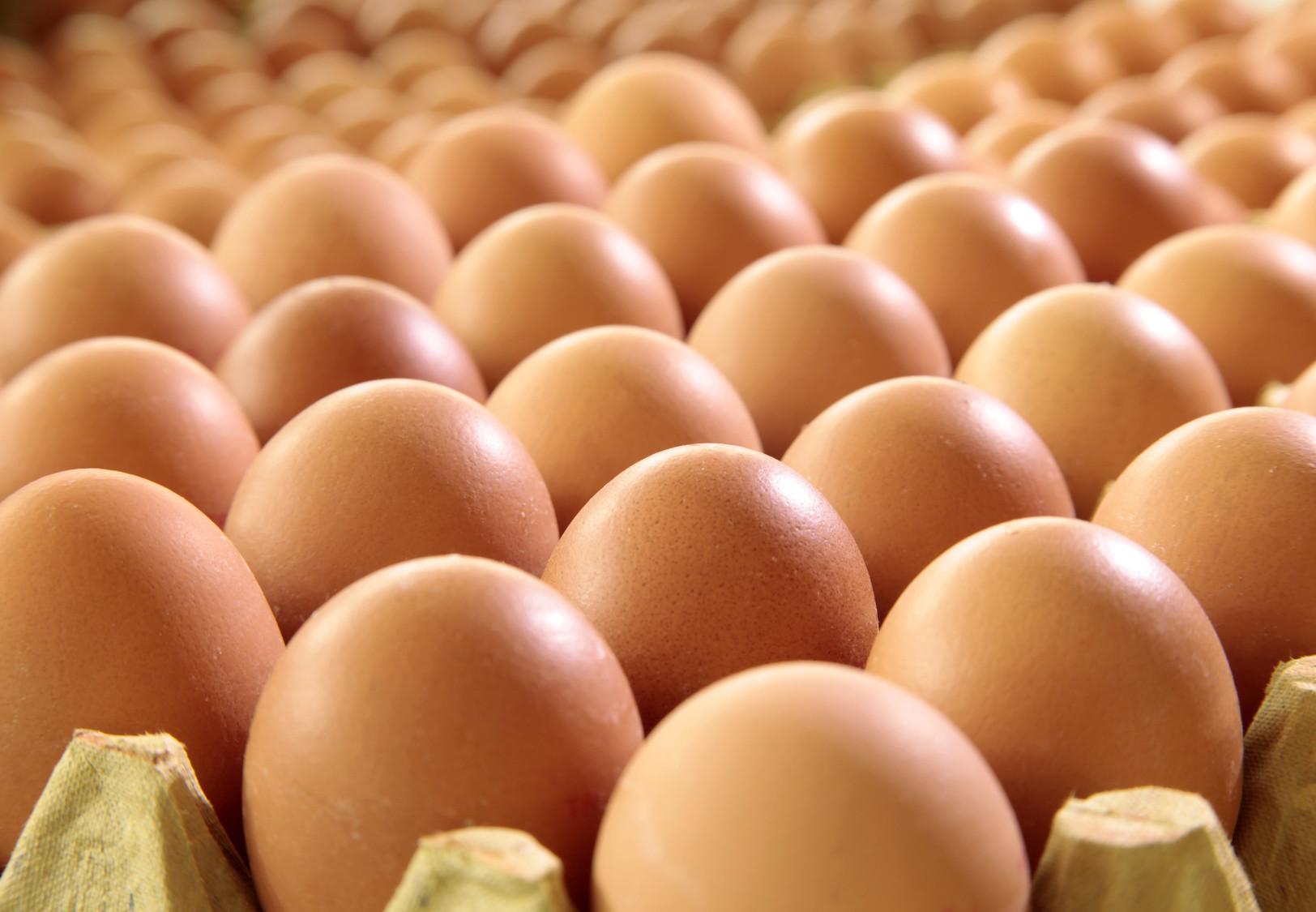
cage eggs - industry overview
In the U.S., egg production is big business.
Today, there are over 300 million egg-laying hens used to produce over 80 billion eggs each year. The majority of these hens spend their entire lives in conventional cages, also known as battery cages.
A battery cage is typically home to 6 hens – sometimes more, leaving each hen with little more than an iPad’s worth of individual space to move in. This lack of space keeps hens from spreading their wings and performing other important natural behaviours such as foraging, nesting, perching, or dust-bathing.
Hens are often injured by the constant friction against the cage and feeble attempts to stretch out can result in their legs, wings, and necks becoming trapped and broken in the cage’s wire frame. In a conventional cage-keeping facility, battery cages are stacked inside a barn. Cages are side by side and one on top of another, allowing for thousands to millions of hens to be kept in one location where they never experience natural sunlight or free range of movement their entire lives.
Past studies have shown that U.S. consumers are becoming more concerned about animal welfare and take it into account when making their food purchases.
A 2016 survey by Lake Research Partners found that 77% of the American consumers surveyed were concerned about the welfare of farm animals. A report funded by the American Farm Bureau found that 89% of Americans believe food companies are doing the right thing when they require their suppliers to treat farm animals better.
Companies are also paying attention to public disapproval of battery cages.
In recent years, many U.S. grocers, restaurant chains, food services and hospitality, and other major food companies pledged to switch to the use of eggs coming from "cage-free" laying hens and 100% cage- free eggs. Some of these companies include:
- Walmart
- McDonalds
- Starbucks
- Burger King
- Hyatt Hotels
- Unilever (which produces Hellmann's Mayonnaise and other products)
Leading food service companies such as Aramark, Compass Group, and Sodexo have already committed to using cage-free only eggs for their millions of shell eggs (fresh or whole eggs) and plan to make the switch for all their liquid eggs (eggs used in processed products like salad dressing and pasta.)
Outside the U.S.
While traditional battery cages have been banned in the European Union since 2012, the so-called “enriched cages” are still very common.
In many other countries around the world battery cages are the norm as well; however, since 2016 the trend to switching to cage-free eggs is starting to occur in Latin America, Canada, and South Africa.
In Europe, a typical laying hen kept in an enriched cage, which is larger than a battery cage depending on the size of the overall compartment, shares her cage with 20 to 60 other laying hens. Perches, nesting boxes, and scratching areas are installed to provide an enriched environment – but considering the confined space hens are hardly able to benefit from these additions.
In Europe, almost 60% of egg-laying hens spend their entire lives in enriched cages.
Labels
In the European Union, labelling of fresh eggs is mandatory in order to enable consumers, retailers, restaurants, and catering companies to make an informed choice and consciously buy eggs from cage-free production systems. Labelling is however not required for hidden eggs, which are eggs used in processed products (e.g. eggs in sauces or baked goods) and eggs used in restaurants and the food industry.
In the U.S., in the absence of labelling requirements, it is up to companies to voluntarily decide whether to label fresh or processed eggs.
Unfortunately, the majority of egg labels used have very little to do with animal welfare and lack well defined, national standards to ensure the truthfulness behind the label, unless the company chooses to be audited and certified by an independent third-party.
In most cases, it is left up to the consumers to investigate, research, and discern the reality behind an egg producers claims for the welfare of their hens.
Millions of hens Continue to suffer in cages

Since January 2012 only so called “enriched cages“ in the EU have been permitted that provide laying hens 750 cm² of space instead of the 550 cm² that was previously allowed. Enriched or not: Any natural behavior is made almost impossible in such a restrictive narrow environment.
U.S. Egg Labels
Common labels for eggs in the U.S. that are relevant to animal welfare include: Cage-free, Free-range/Free-roaming, Pasture-raised, and Certified Organic.
FOUR PAWS defines cage-free to be a housing system where no laying hens are kept in any cages – conventional or enriched ones.
A typical cage-free system has hens that are uncaged inside barns, which allows them to display natural behaviors and have greater range of movement; however, the hens are usually kept indoors year-round. Therefore, this makes going cage-free an important first step.
FOUR PAWS believes that minimum standards for egg-laying hens should be set for the welfare of the hens and to provide a more humane, healthy, and sustainable product. Additional humane standards that go beyond just cage-free egg production include free-range, pasture-raised, or certified organic housing.
Free-range hens are typically uncaged inside barns and may have limited access to the outdoors. Alternatively, pasture-raised hens are often outdoors most of the time with access to vegetation and kept inside at night for protection from predators.
Organic kept hens are uncaged inside barns, required to have outdoor access, and fed an organic diet free from pesticides and antibiotics. Yet for all of these housing systems, there are no government-regulated standards to assure that these “typical” housing situations actually occur. Even for organic, while outdoor access is required the amount, duration, and quality of access are undefined and left up to the discretion of the farm.
Therefore, another vital component to the label cage-free is having the farms be certified by an independent third party, which provides a more reliable guarantee of the housing system than just accepting the label at face value. One example is Certified Humane, which is a leading certification program that has three levels of certification: cage-free, free-range, and pasture-raised, and they provide extensive information on the standards required for approval for each one. Additional third-party auditor programs include: Animal Welfare Approved, American Humane Certified, Food Alliance Certified, and United Egg Producers Certified.
According to the United Egg Producers: "In 2017, nearly 16% of all hens are in cage-free production, up from 12% in 2016 and 4% in 2010. As of October 2017, organic and cage-free shell egg production accounted for 15.8% (49.3 million hens) of the current table egg layer flock. Of this, 5.0% are organic (15.6 million hens) and 9.7% are non-organic cage-free (30.2 million hens)."
Additional Welfare Issues
Naturally all husbandry systems are only as good as the management for them is. Even in free-range and organic systems animal welfare problems can occur when the animals are not properly cared for.
Fact is today’s egg production industry is tailored towards economic efficiency. This usually has negative consequences for the welfare of the animals. In industrialized keeping systems, high stocking densities and flock sizes (hundreds to thousands of birds) are common and encouraged by the industry.
In the hatcheries that supply commercial operations with hens, be it cage or cage-free facilities, all the male chicks are killed. They are killed shortly after birth and cruelly – usually by suffocation, gassing, or grinding, as they are considered an unwanted by-product of egg production.
Considering males don’t lay eggs nor are they bred to produce as much meat as chickens used in the meat industry, letting the males grow up for slaughter is just not profitable enough for the industry. Laying hens are usually slaughtered after 72 weeks of age, after their high volume egg production begins to decrease.
To add to the cruelty, hens face additional pain from beak trimming, which is a partial removal of their beaks done soon after they hatch. This is said to prevent harmful feather picking and cannibalism at a later stage. Both feather picking as well as cannibalism are symptoms of keeping conditions that do not meet the needs of the animals. Beak cutting is allowed even in organic farming systems.
It is important to realize that a hen is more than an egg-laying machine, as all chickens are sentient beings with complex behaviors and needs.
Why Labelling Matters
Throughout the world billions of eggs from cage-keeping systems are used in fresh and processed food every year. In the absence of proper labelling for both fresh eggs and processed/hidden eggs, consumers are not provided the opportunity to make a conscious decision to choose products that were produced in a more animal-friendly manner.
Labels should also be held to strict and well-defined standards and audited by independent third parties, so that consumers aren't mislead by what the label says versus what it actually means.
This is why FOUR PAWS demands a ban on all cage systems for egg-laying hens and mandatory labelling that states how all laying hens were kept when their eggs are used in fresh or processed foods.
